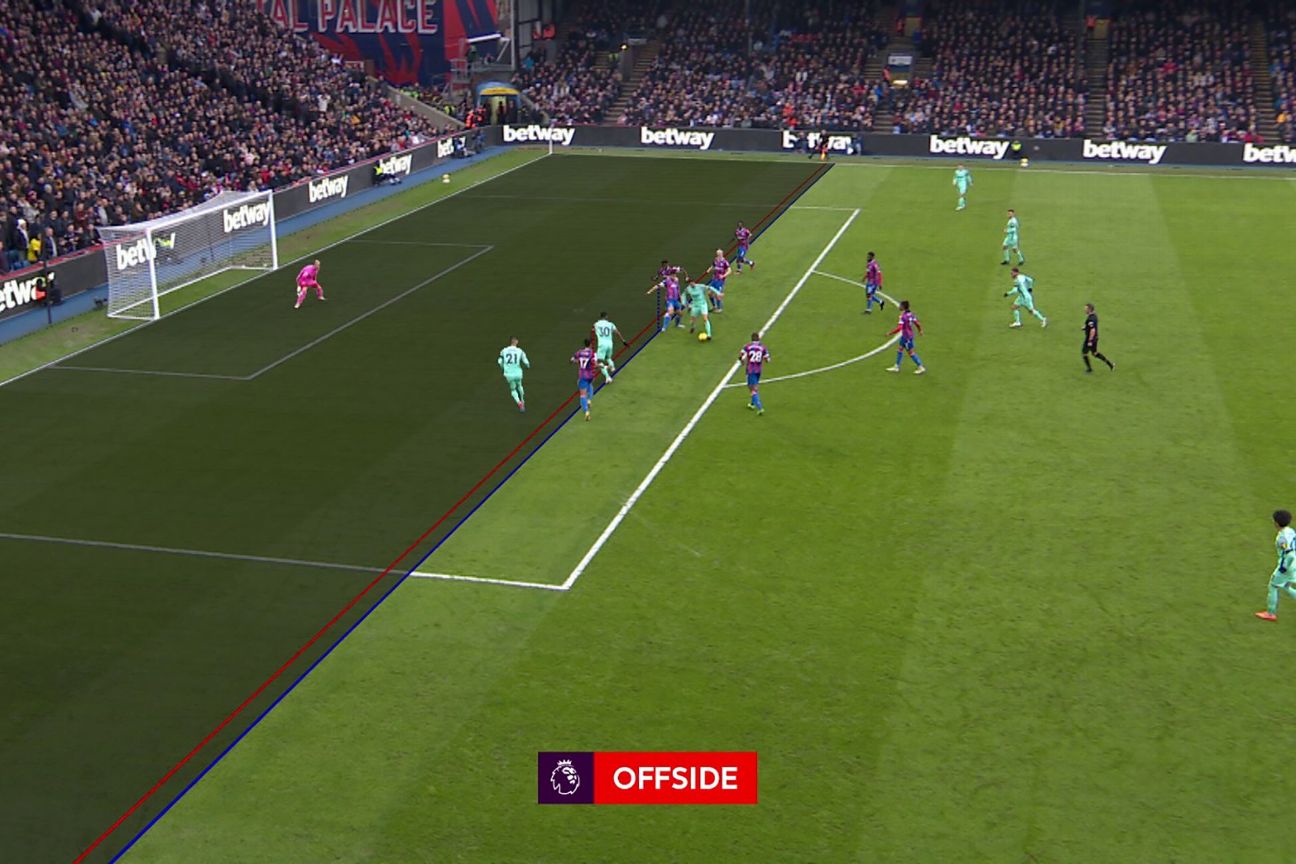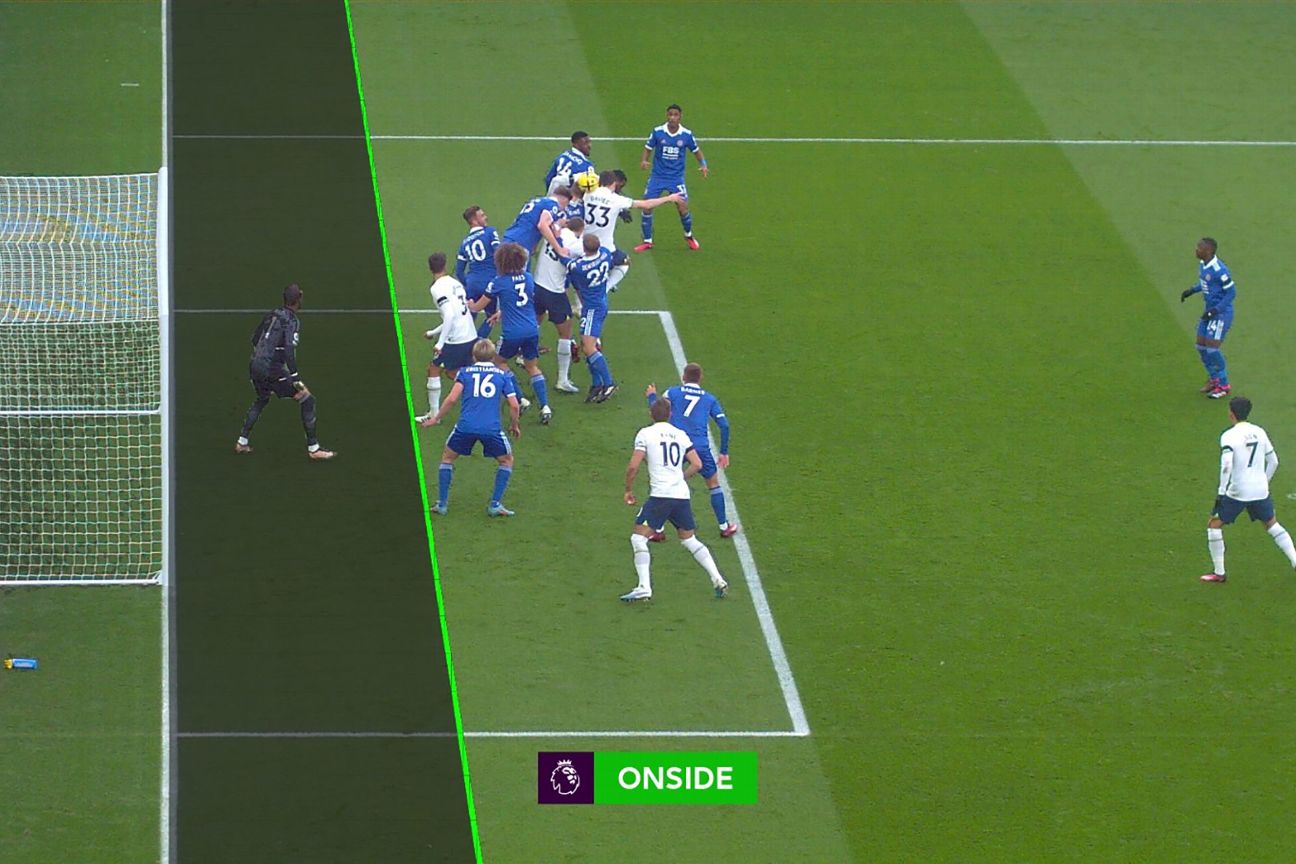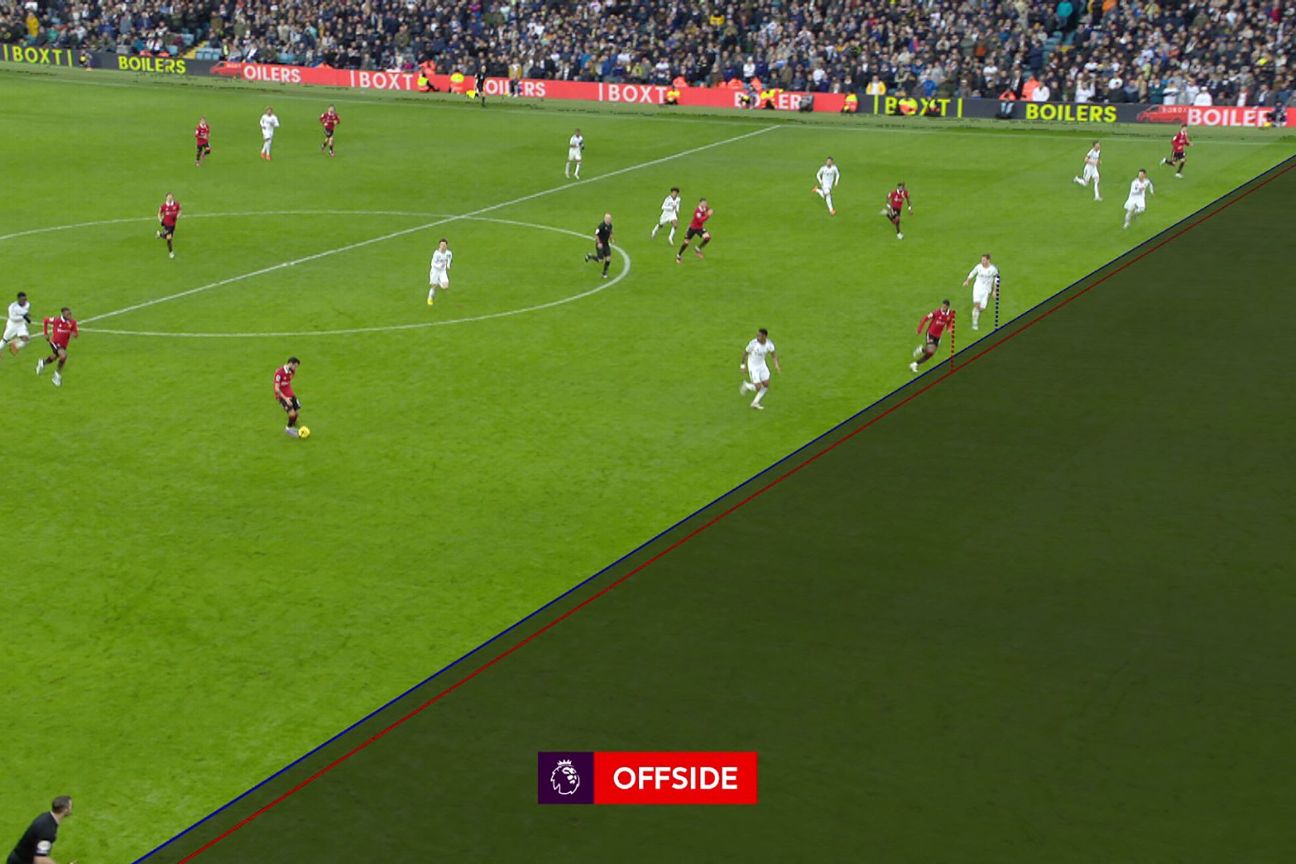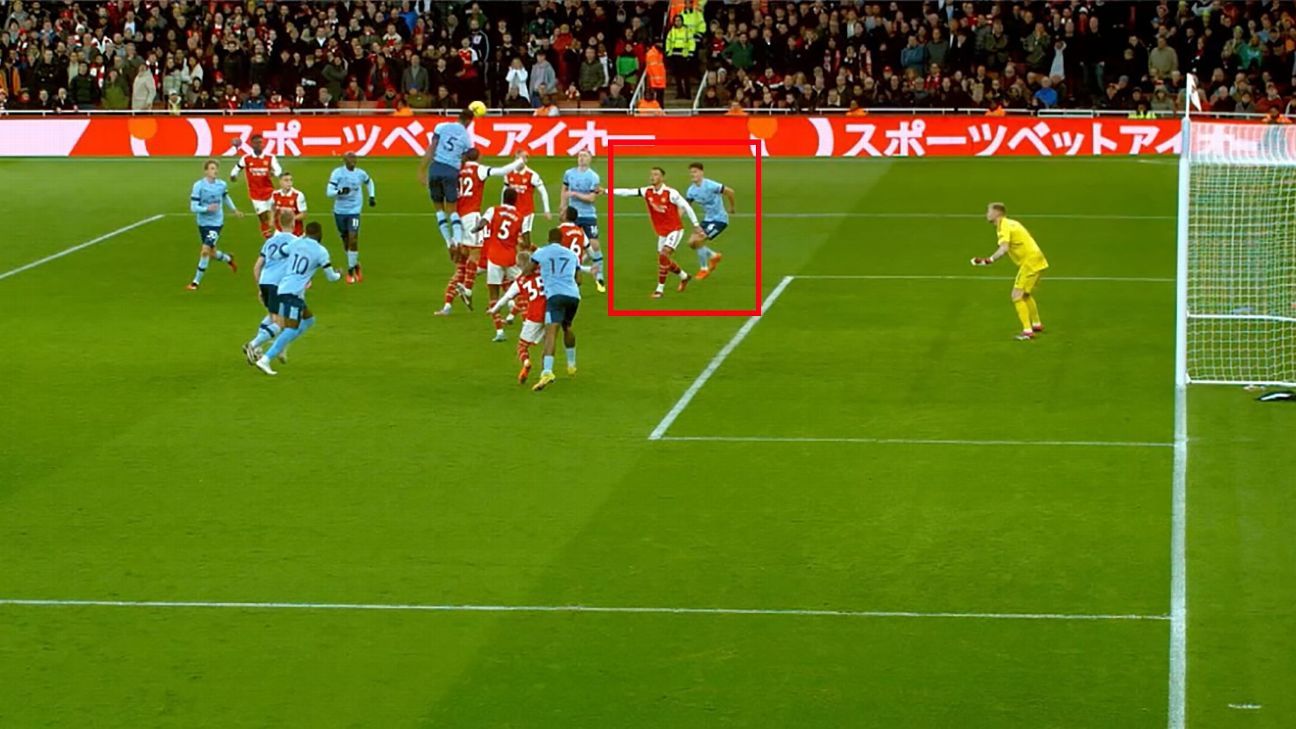Video Assistant Referee causes controversy every week in the Premier League, but how are decisions made, and are they correct?
After each weekend we take a look at the major incidents, to examine and explain the process both in terms of VAR protocol and the Laws of the Game.
– How VAR decisions affected every Prem club in 2022-23
– VAR in the Premier League: Ultimate guide
JUMP TO: Arsenal 1-1 Brentford | Palace 1-1 Brighton | West Ham 1-1 Chelsea | Man City 3-1 Villa | Leicester 4-1 Spurs | Leeds 0-2 Man Utd
VAR’s worst weekend?
In the last 12 months, PGMOL has begun implementing the Elite Refereeing Performance Plan to improve standards, with a large number of coaches and support staff brought in. That included appointing Howard Webb as the new chief of refereeing.
Webb enjoyed a smooth start to the job, but as mentioned in the VAR Review a few weeks ago there was never a magic wand to fix the underlying issues. It’s going to take time to transform the organisation, both in terms of referees on the pitch and in the VAR hub, but weekends as poor as this have to be avoided.
In September, the Premier League took the unprecedented step of asking PGMOL to explain VAR decisions to disallow goals for West Ham United at Chelsea, and Newcastle United against Crystal Palace. But it’s one thing making mistakes over the subjective calls in those games, and another thing entirely when the VAR is unable to effectively use technology to make an objective offside decision.
That said, the general picture isn’t as bad as some may think, as only a fraction of the situations supporters believe are incorrect officially get classed as mistakes. For instance, the Marcus Rashford offside situation in the Manchester derby wasn’t judged to be an error by the independent panel.
The mistakes which potentially cost Arsenal two points at home to Brentford, and Brighton & Hove Albion a possible victory at rivals Palace, were wholly avoidable and suggest a lack of concentration and application.
Missing an offside against a player who has created a goal, or placing the offside line to the wrong player, have quite rightly been described by PGMOL as “significant errors in the VAR process.” Webb is determined to be more open about errors, so the Premier League won’t need to publicly demand a response like it did earlier in the season. “Human error,” as PGMOL called it, will be unavoidable but has to be limited through improved performance.
Webb has moved swiftly to react. John Brooks, the VAR for Palace-Brighton, was due to be in the hub for Liverpool vs. Everton on Monday night and Arsenal vs. Manchester City on Wednesday evening and has been replaced for both matches.
The fate of Lee Mason and Neil Swarbrick will be known on Tuesday, when the Premier League appointments for the weekend are announced.
A major problem is that many of these errors are being made by officials whose sole job is VAR.
Mason, who failed to disallow the Brentford goal, was the Premier League’s first full-time VAR and is into his second season, but has made six confirmed mistakes this campaign. He was responsible for two errors that weekend in September.
Swarbrick, who is the Premier League’s head of VAR, failed to award a penalty to Chelsea on Saturday, and was also responsible for the missed red card to Liverpool midfielder Fabinho at Brighton in the FA Cup, another error PGMOL admitted to.
Mason, Swarbrick and Mike Dean, the other official who only works on VAR, have been responsible for around half of all errors this season (wrong and missed interventions), when they should be the experts in their roles. It shows that being an experienced referee doesn’t necessarily mean you have the skills to be an effective VAR.
Possible offside: Pinnock and Norgaard on Toney goal
What happened: Brentford equalised in the 74th minute through a free-kick routine. Mathias Jensen floated a ball to the back post for Ivan Toney to help back across the area. After the ball was headed around the box, Pinnock nodded it forward, which Christian Norgaard latched onto and hooked it back across the six-yard box, and Toney headed home. There was a VAR check for offside in the phase against Ethan Pinnock.
VAR decision: Goal stands.
VAR review: Mason didn’t forget to draw the lines, it’s far more nuanced than that — but it doesn’t change the fact this was a huge error.
There are three possible situations — one foul and two offside.
1. Did Pinnock foul Gabriel?
There’s no doubt that Pinnock is in contact with his opponent, but there wasn’t enough in it to be considered a blocking action for a foul.
2. Was Pinnock interfering with an opponent from an offside position?
This is the first key question, and where it essentially began to fall down for Mason. Did Pinnock impact Arsenal defender Gabriel from an offside position, preventing him from closing down Toney at the far post on the initial play of the free kick?
When the attacking player is in an offside position, the burden of proof for interference when touching an opponent is far lower than for a foul. You don’t have to consider Gabriel would have won the ball, only that his ability to challenge for the ball has been affected.
Mason correctly judged that Pinnock had interfered with his opponent. This was enough for the offside defence, but Mason has to be sure Pinnock is offside. There was no camera angle which clearly showed Gabriel’s right-hand side, the part of his body closest to goal which is needed for an offside decision.
From the replays, it certainly looks like Pinnock is just in front of Gabriel, but without being able to see the position of the defender’s right side it’s impossible to be certain. Mason cannot give offside and, in this part of the decision, was correct to clear it and move onto the rest of the phase.
3. Norgaard offside
Mason had taken 2 minutes and 20 seconds to judge the first offside, considering the possible foul and then the offside offence — including trying to find a usable camera angle for the technology.
The rest of the attacking phase should then be checked, and it seems this was rushed. The goal was awarded after another 14 seconds, and just a quick check of the phase. Did the amount of time he had taken already affect his decision-making on the rest of the move?
Mason didn’t notice that Norgaard had tracked back from an offside position, before moving forward again to set up Toney for the equaliser. The possible offside offence was not identified, so the offside technology wasn’t applied.
While we cannot be certain without the offside line being drawn, PGMOL has admitted that this was an error and Norgaard was marginally in front of Ben White when the ball was headed forward. You can possibly excuse missing a marginal offside further back in an attacking move, but to miss it against the player who created the goal is a huge error.
Semi-automated offside technology, as used in the Champions League, would eliminate problems such as being unable to plot Pinnock, or missing Norgaard, as all 22 players are automatically mapped and the VAR is given an instant notification of an offside player; the human error aspect is removed. It was introduced into Serie A two weeks ago, prompted by a major offside error in a game earlier in the season. The negative aspect is the technology is more accurate, leading to the return of goals being ruled out for marginal offsides. The Premier League is non-committal about bringing this in for next season, but the body of evidence to move away from this older system is growing.
Disallowed Mbeumo goal
What happened: In the 12th minute, Bryan Mbeumo broke through the centre and fired a shot past Aaron Ramsdale, but referee Peter Bankes had already blown the whistle for a foul on Gabriel.
VAR decision: No intervention possible.
VAR review: The in-play remit of the VAR ends as soon as the referee stops play, as the game is dead at that point. So even if the VAR was to identify this wasn’t a foul by Mbeumo, it is impossible to allow the goal — because the goal didn’t exist.
If the referee had held his whistle and blown after the ball crossed the line, the VAR could tell the referee he had made a mistake penalising the foul and advise the goal should be awarded.
Compare it to Ilkay Gundogan‘s disallowed goal in the 14th minute of Manchester City‘s game against Aston Villa. After Erling Haaland collided with Emiliano Martinez, referee Robert Jones held his whistle until Gundogan put the ball into the net. Then he awarded the foul, and while the VAR supported that decision he would at least have had the right to advise the goal should stand.
It was extremely harsh on Brentford, because there was no foul by Mbeumo before he broke through — though the whistle did go straight away and Arsenal’s players stopped.
Possible offside: Estupinan when scoring
What happened: Brighton scored in the 32nd minute when Pascal Gross played in Pervis Estupinan, who finished past Vicente Guaita, but there was a VAR check for offside.
VAR decision: Goal disallowed.
VAR review: The second major error of the weekend, with the VAR, Brooks, and the Hawk-Eye technology operator failing to apply the offside line correctly. It was placed to the feet of the third-last defender, which made Estupinan offside.

As with Norgaard, we cannot be certain without the lines, but PGMOL has admitted this was an error and had the lines been drawn to the correct defender, Marc Guehi, Estupinan would have been onside.
The tech operator plots the line, which the VAR then approves. Brooks and the operator managed to do half the job correctly, but somehow they mixed up two players stood close to each other and plotted the offside line too far back.
Using the image below, we can show where it went wrong.
Red circle to the arm of Guehi and Tomkins
The vertical line is actually correct, if you follow it up it would stop on the correct part of Guehi’s upper arm. But for some reason the tech operator has clicked to plot it only as far as James Tomkins‘ elbow. Not only is this the wrong player, it’s not even a part of the body valid for an offside situation. How both Brooks and tech operator have missed this is hard to comprehend because with the line stopped on Tomkins, it causes a knock-on effect for the goal to be disallowed.
Red square to the feet of Tomkins
The VAR and the tech operator now confuse the situation. As they have stopped the vertical line on Tomkins, they are now only looking at that player, and they plot the pitch line to his feet, and not Guehi’s.
It effectively means Guehi is around 7-feet tall, with the vertical line to his upper arm, but to the feet of Tomkins.
This leads to an offside line which is too far up the pitch, and makes Estupinan incorrectly offside.
Possible red card: Mac Allister challenge on Doucoure
What happened: In the 6th minute, Alexis Mac Allister stretched for a ball in a challenge with Cheick Doucoure and caught the Crystal Palace player on the shin. Referee Michael Oliver showed Mac Allister a yellow card (watch here.)
VAR decision: No red card.
VAR review: A classic case of where an image doesn’t tell the whole story of a challenge, giving the impression of a tackle which must have endangered the safety of an opponent.
Excessive force must be present, or the challenge has to endanger the safety of another player. Mac Allister mistimed his attempt to win the ball and made contact with Doucoure above the ankle, but there certainly wasn’t enough for the VAR to rule a yellow card wasn’t an acceptable disciplinary outcome.
Possible penalty: Handball by Soucek
What happened: In the 89th minute, Conor Gallagher had a shot on goal from the edge of the area. Tomas Soucek went to ground to block the shot and it hit his left arm, taking all the pace off the ball as it ran through to goalkeeper Lukasz Fabianski.
VAR decision: No penalty.
VAR review: When is the arm supporting the body, and when is it being placed in a position to block the path of the ball? This is the whole crux of the decision; the former isn’t a handball offence, the latter is.
The judgement of the VAR, Swarbrick, was that Soucek was putting his arm to the ground to break his fall, and therefore there’s no grounds to overturn the decision of the referee, Craig Pawson.
It’s a very weak argument to suggest Soucek is supporting his body. It seems very clear that in diving to block the shot from Gallagher he places his arm into the path of the ball: it’s enlarging the size of his body and is effectively a save, it should have been a penalty and a caution for Soucek for blocking a shot on goal.
It’s as though too much stock was placed on the “supporting arm” element of the law, rather than what seemed like an obvious movement to stop the ball.
This wasn’t included in PGMOL’s admission of errors for the weekend as there was a subjective argument in favour of no penalty, but it is accepted that it should have been awarded.
It’s different to the incorrect VAR intervention at the World Cup, when Uruguay‘s Jose Maria Gimenez was wrongly penalised for handball with the supporting arm against Portugal. Gimenez was falling backwards to make a challenge and the ball hit his arm behind his body, and this shouldn’t have been given.
It’s worse that Swarbrick’s was such a swift check, with play allowed to continue. Compare it to the offside decision against Declan Rice six minutes earlier, which meant a goal for Soucek was correctly disallowed. It took a long time for Swarbrick to apply the lines and disallow the goal for what looked to be a clear offside, as was proved by the gap between the offside lines.
Swarbrick has been the head of VAR for the Premier League since the system was introduced at the start of the 2019-20 season, but he had not taken on the role in live matches until recently. ESPN has been told that Swarbrick remains the head of VAR, despite taking on active duties six times in 2023.
His first game was the FA Cup tie between AFC Bournemouth vs. Burnley on Jan. 7, and since then he has been the VAR on games every week.
As well as being the VAR for the Premier League game between Brighton & Hove Albion and Liverpool on Jan. 14, he was also in the Stockley Park hotseat two weeks later when the teams met in the FA Cup, when a clear red card for Fabinho was missed.
He has also acted as the VAR for Crystal Palace vs. Manchester United and Newcastle United vs. West Ham United.
1:57
Laurens & Hutchison tear into VAR for Soucek handball decision
Julien Laurens and Don Hutchison cannot understand why Chelsea weren’t awarded a penalty against West Ham.
Penalty awarded: Grealish fouled by Ramsey
What happened: Manchester City were awarded a penalty in the 44th minute when Jack Grealish was tripped by Jacob Ramsey.
VAR decision: Penalty stands, scored by Riyad Mahrez.
VAR review: We have seen this kind of penalty more regularly over the last couple of seasons, where an attacker has his back leg clipped as a defender is running behind him, causing the attacker to trip over himself.
Even though there has been no actual challenge, the defender remains in charge of where they are running; if the attacker is impeded, even accidentally, it will not be a wrong decision by the referee to award an penalty kick. The VAR won’t advise an overturn if he finds contact to cause the trip — as long as that contact hasn’t been initiated by the attacker.
Possible offside: Bentancur when scoring
What happened: Rodrigo Bentancur gave Tottenham Hotspur the lead in the 14th minute, but there was a check for a possible offside.
VAR decision: Goal stands.
VAR review: Bentancur was shown to be onside by the technology, but many fans questioned why it was even checked. After the ball deflected off Ben Davies, Victor Kristiansen attempted a clearance and it fell to Bentancur.
When a player plays the ball close to goal it’s technically considered a save, and not a “deliberate play.” The defender is effectively acting like a goalkeeper, and an attempt to stop a ball going into the goal will not reset the phase. If the technology had shown Bentancur was in an offside position, the goal would have been disallowed.
Bentancur is only onside due to the tolerance level in this offside system, with his toe marginally in front of the last defender. With semi-automated offside technology, this goal would likely have been disallowed.

Possible onside: Weghorst goal
What happened: Deep into added time, Wout Weghorst had the ball in the back of the net but the flag went up for offside.
VAR decision: No goal.
VAR review:
All the VAR, Michael Salisbury, needs to find is any touch on Harry Maguire, and that sets the offside phase. And subsequent touch or deflection off a Leeds player does not alter the phase.
Salisbury identifies the ball does touch the head of Maguire, at which point Weghorst is well in advance of the last defender.
There were also two offside decisions involving Marcus Rashford — both correct by the assistant and confirmed by the VAR. The striker was onside for his goal, but offside when he scored what was a late third goal for Manchester United.


Information provided by the Premier League and PGMOL was used in this story.
